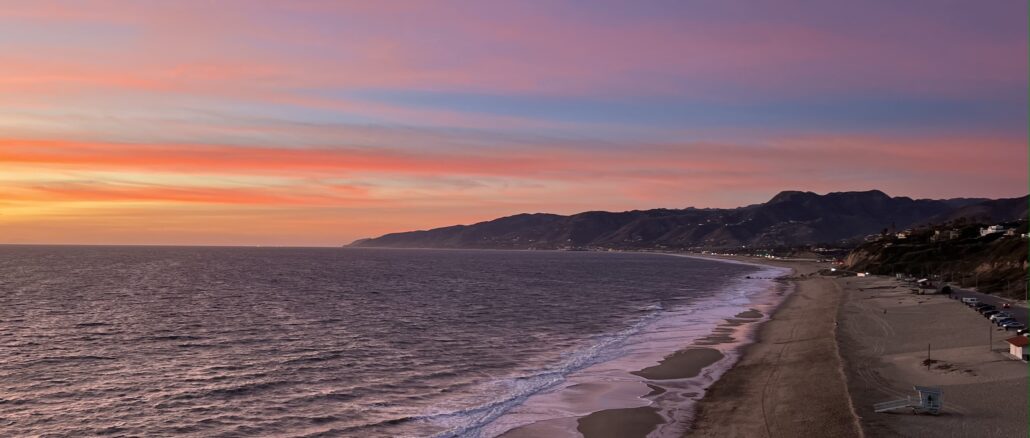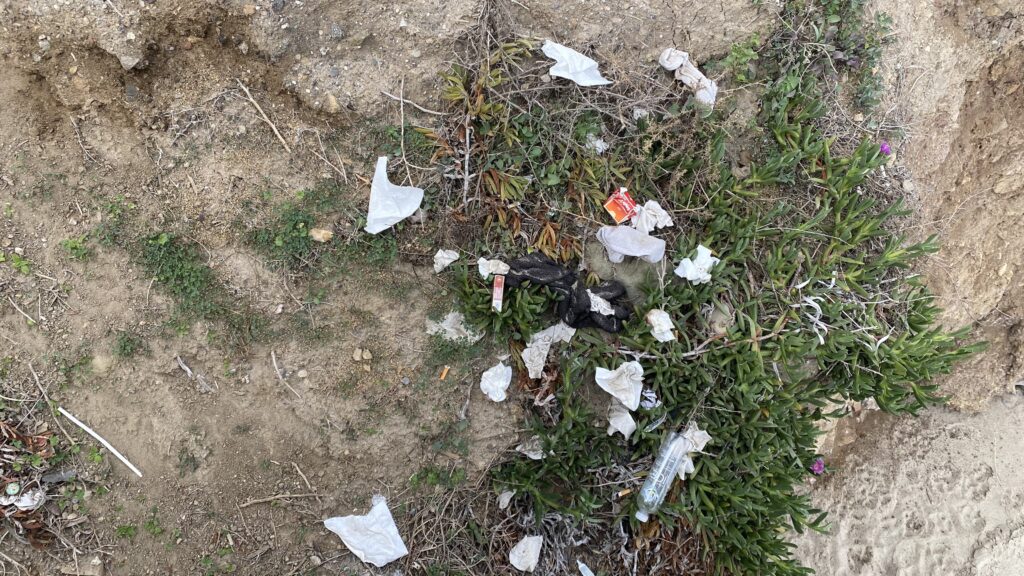
The Malibu City Council is fighting a losing battle.
Climate change and sea-level rise keeps eroding the sand and the road at Westward Beach at Point Dume, but the council can only mitigate the problem. The ocean will one day win.
After a storm surge, strong waves and high tide partially destroyed the road in August 2021, the Malibu City Council restored the road in a month and reinforced it with rocks.
This is just a temporary solution that leads to even faster sea-level rise, said Karen Martin, retired Pepperdine biology professor. When the water reaches the rocks it recedes faster, taking more sand with it back to the ocean.
More long-term solutions to save the beach and the road are money and time intensive, such as restoring the natural environment on the beach by making dunes or moving development further from the ocean.
“Malibu is famous for its beaches,” Malibu City Councilman Steve Uhring said. “It is not famous for its sidewalks, so we want to keep the beaches and make sure we protect them.”
Public officials and private foundations are exploring solutions to prevent sand erosion, protect structures from destruction and keep beaches from disappearing.
Сlimate change raises sea levels
Climate change happens because of the actions of human beings, according to the European Commission. People produce a lot of greenhouse gasses that increase the Earth’s temperature and contribute to global warming, melting glaciers and raising sea-levels, which in response affects beaches.
“During the last 20 years, record warming hits every year,” Martin said. “This warming is not only melting the ice but it also expands water size itself, which leads to sea-level rise.”
The rate of sea-level rise is accelerating. It has more than doubled from 0.06 inches per year throughout most of the twentieth century to 0.14 inches per year from 2006–2015, according to a NOAA article. The National Academies of Sciences, Engineering, and Medicine predict sea levels will rise about 12 inches over the next four decades on the West Coast.
“At this point we are studying climate change, erosion and what it would mean for each of our beaches but we probably would not get results for at least another year,” said Nicole Mooradian, public information officer of the County of Los Angeles Department of Beaches and Harbors. “We truly care about our coast lines and we are open to ways in which we can preserve public beaches.”
Solutions to sea-level rise
There are different solutions to the sea-level rise problem. Researchers divide these into hard solutions, like building sea walls that damage nature but save structures. There are also soft solutions that aim to preserve both, such as restoring sand dunes with native plants.
“Sea walls prevent water from getting to structures but the problem is when waves hit them it increases their force when they are coming to the ocean again, and so whatever sand is right next to the wall will end by being washed away and eventually it makes the beach disappear completely,” Martin said.
Sea walls are just a temporary measure because the ocean keeps taking what it wants.
California has a lot of structures that are right next to the beach, along with roads and sidewalks that are under threat. The state is planning over $6 billion in sea-level rise solutions, according to the Sea-Level Rise organization. Most of the money will go to save the existing structures and attempts to prevent further sea-level rising.
Another strategy is where people let nature take over. It is called managed retreat, which involves abandoning or tearing down homes and other structures and moving inland, Mooradian said.
This plan is a tough sell to homeowners and businesses who like their ocean-front locations, Uhring said.
“The Coastal Commission does not want seawalls and they ask people to move their houses but people do not want to do it,” Uhring said. “It will be a long process in the court to move them or the ocean will just destroy the house.”
Malibu residents and the Malibu City Council have brought in sand to refill local beaches but it was very expensive and did not show any results in the long run, Uhring said.
The Bay Foundation has developed soft solutions to the sea-level rise problem, like restoring vegetation and creating natural dunes, said Tom Ford, the foundation’s chief executive officer. Their main goal is to protect and restore the coasts of Los Angeles County.
Dunes are essential for the ongoing maintenance of the natural beach system. They prevent flooding and erosion, according to Naturally Resilient Communities website. They also act as a repository for sand to naturally replenish beaches that have experienced significant erosion from coastal storms.
The Bay Foundation already restored sand dunes in Santa Monica.
“During six years the beach and the plants have grown a meter in height and we did not have to do much,” Ford said. “I was impressed with how little we had to do to make that happen.”
They are working with Malibu and LA County to analyze the success of that project and expand their efforts, including to Westward Beach.
“We do not try to force a solution if it does not fit,” Ford said.
Westward Beach Road
Most of the beaches and structures right next to the ocean suffer from sea-level rise, which is how ocean waves destroyed part of Westward Beach Road.
“The reason Westward Beach is being chewed up by the ocean is because they destroyed all the dunes when they made that beach,” Uhring said. “And the County of Los Angeles Department of Beaches and Harbors did not do much to protect it, they should have started years ago.”
The Beaches and Harbors department put a rock barrier between the beach and the road and created dunes on top of the rocks, but it just destroyed more of the sand, which leads to faster sea-level rise.
“What happened with Point Dume beach is the result of storm surge, strong waves and high tide and to a certain extent while you can try to protect that, erosion happens,” Mooradian said.“It is a natural process and it is only an issue when it comes in conflict with structures that we have built.”
The Malibu City Council has no long-term plans for Westward Beach Road, Uhring said.
“Five, six, 10 years from now Westward Beach Road will be covered in water and why do you want to spend $6 million on something that no one will be able to use?” Uhring said.
Bay Foundation wants to try to prevent Westward Beach from disappearing, Ford said.
“We have a project at Westward Beach right now where we cleared out a bunch of iced plants because they are not as good as native plants in holding the sand and building sand dunes, it does not support the wildlife as native plants,” Ford said. “So, we planted native and sustainable plants on the beach and in five years we hope that we will have wildlife and sand dunes that are adding to the beauty of the beach and protecting the beach from sea-level rise.”
Residents and tourists can help
“People should recognize that climate change is real, sea-level is rising and there is a threat on our beaches,” Ford said. “We should start seriously doing work to keep our beaches.”
This work does not have to be uncomfortable or overwhelming. There are easy steps such as using reusable shopping bags, buying only what one needs and trying to avoid plastic packaging, according to the World Wide Fund for Nature website.
Another important and easy step is to clean up after oneself when on the beach.

“The problem we are having with tourists is that they are leaving a lot of trash,” Uhring said. “Pack up whatever you bring in.”
The Pepperdine Green Team hosts monthly beach clean-ups and meetings to discuss environmental problems.
“Students are very receptive to conversations about sustainability issues,” said Lauren Chivers, a junior philosophy and sustainability major and vice president of community planning for Green Team.
These steps can help to decrease emissions, prevent further climate change and preserve the beaches.
“There is some time to figure out how we are going to deal with the beaches, I do not want to pretend like this is easy or that we do not have to worry about it,” Ford said. “This is today’s issue and we should work smartly together finding resources and trying to protect these beaches if we want them to stay. If we ignore them, they will go away. And no one wants that.”
Taisiya Pachkaleva reported this enterprise story in Jour 241 during the Spring 2022 semester under the supervision of Dr. Christina Littlefield and Dr. Theresa de los Santos. Dr. Littlefield supervised the web article.




